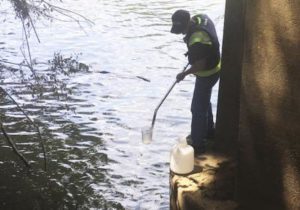 The hot and dry weather conditions mean it’s a busier time at Louisville Water’s treatment plants. The weather also changes the conditions of the Ohio River. Yesterday, the Kentucky Division of Water and the Kentucky Department for Public Health issued a recreational public health advisory for the Ohio River near Louisville. The advisory was issued because scientists detected a harmful algal bloom.
The hot and dry weather conditions mean it’s a busier time at Louisville Water’s treatment plants. The weather also changes the conditions of the Ohio River. Yesterday, the Kentucky Division of Water and the Kentucky Department for Public Health issued a recreational public health advisory for the Ohio River near Louisville. The advisory was issued because scientists detected a harmful algal bloom.
This is not an issue for Louisville’s drinking water. Our product is the same high-quality, great-tasting water customers are accustomed to receiving. The advisory means swimming, wading, and other water activities that create spray are not recommended in areas impacted by the bloom.
What’s happening? Algae occur naturally in the environment and, in fact, they are an important part of the ecosystem. Algae blooms happen when there’s excess nutrients in the water, sunny conditions, warm temperatures, and low flow — resulting in rapid growth of algae.
Typical algae blooms we often see in creeks and rivers do not produce toxins. Toxins are only produced by certain types of algae. Blooms of these algae are referred to as harmful algae blooms, or HABs.
Louisville Water is Prepared
Our scientists know a lot about the Ohio River. We do over 200 tests daily on the river and drinking water supply. We continuously watch river conditions and, since July, have increased our monitoring. (The photo above shows Louisville Water Scientist Roger Tucker collecting a water sample.)
We know when there’s a lack of rain and the weather is sunny and hot, conditions are good for algae to thrive. In some cases, when algae naturally bloom and die, it can create a musty odor in the water. That’s why our monitoring and treatment strategy is key. We use activated carbon to remove these taste and odor elements, so Louisville’s drinking water tastes great.

